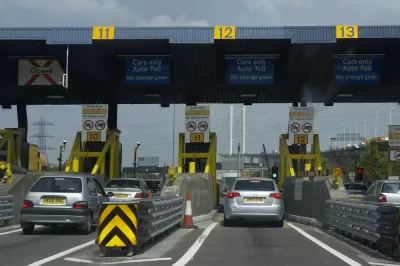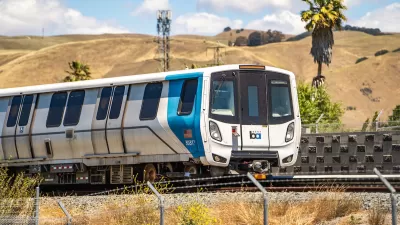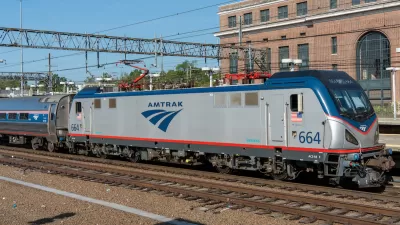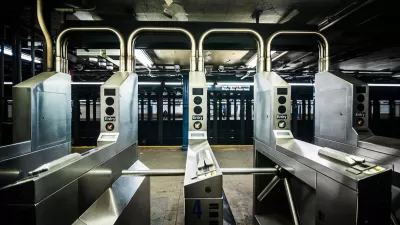The New York MTA this week approved reduced fares for low-income riders. According to blogger Steven Polzin, that decision might have unintended consequences. Asking users to pay for transportation is a complex proposition.

Talking about transportation funding appears increasingly to be akin to pounding one's head against the wall hoping to cure a headache. Major infrastructure legislation and funding plans appear to be perpetually six months away from delivery. Even absent implementation of a programmatic approach, spending at the federal level is creeping up well beyond administration proposals and prior federal legislative plans. What has not changed is the absence of any attempt to synchronize dedicated federal transportation revenues and spending levels. A 1970s era TV commercial for Fram oil filters gave rise to the common phrase, "Pay Me Now or Pay Me Later." The phrase seems apropos, as both the deficit in current committed revenues versus current spending levels and the deficit in infrastructure needs versus infrastructure spending continue to grow. The "pay me later" ledgers are getting bigger and bigger.
Any expectation that transportation could escape the highly partisan divide in Washington appears to have taken an exit. While the desire to spend seems bipartisan, resolving what to spend it on and how to fund the spending have proven intractable. The challenges in transportation funding are increasingly interwoven with sensitivities regarding the incidence, or burden, of various revenue strategies on different segments of the population. Be it direct charges (such as ticket or fare prices, toll prices, and parking prices), less direct charges (such as fuel taxes), or even indirect funding strategies (such as property and sales taxes), policy makers are increasingly sensitive to how those costs will impact various population groups. How we fund transportation is important to transportation planning. How we fund transportation influences travel behavior and feeds back to affect travel demand. Greater attention to the incidence involved with transportation funding dramatically complicates transportation planning and decision making.
Historically, local, state, and federal transportation funding strategies were comfortable with significant dependence on a user fee concept, where fuel taxes were arguably proportional to the benefits travelers accrued by using the transportation infrastructure. It was not a perfect system. There was credible evidence that certain market segments, for example heavy trucks and alternatively fueled vehicles, were under paying, as were pedestrians, bicyclists, and transit riders—all of whom benefited from Highway Trust Fund expenditures. However, in the realm of political compromise, these were acceptable trade-offs for consensus decision making. Now the fundamental consensus appears to be unwinding at a time that both jeopardizes future funding commitments and undermines the prospect of the private sector playing a greater role in meeting transportation needs. Part of that unwinding is, no doubt, attributable to the consensus building trade-offs that resulted in some payers feeling the "contract" had been broken as the relationship between what one pays and how one benefits has been substantially weakened.
Concern about market-based pricing is perhaps most apparent in the area of toll roads and managed lane projects. Some policy makers are nervous about the social implications of market-based pricing for toll facilities. Nobody seems particularly upset with airlines charging dramatically higher prices for first class or last minute airline tickets, but congestion pricing seems to raise the specter of inequity. That concern is exacerbated when the charges are not reinvested in the facilities and services from which they are collected. Folks have rationalized toll payers on the Dulles Toll Road paying toward the Metrorail Silver Line, so why not raise airline fares to pay for Amtrak? If market-based pricing bleeds off dollars to buy something else that politicians feel worthy, is it then easier to rationalize politically influenced pricing as well?
Part of the momentum behind the privatization of toll roads was simply to privatize the decision-making on toll setting—removing it from the public scrutiny that stymied the political will to increase toll rates and capture the revenue generating potential of important roadways. The public quite readily tolerates roadway tolls, public or private, that can average $.10-$.20 per vehicle mile for light vehicles, but we are seemingly unwilling to increase fuel taxes that, at the federal level, are averaging under one cent per mile. A cause of the reluctance to raise fuel taxes at the federal level comes from concern that it would disproportionately impact low-income individuals, who spend a larger share of household spending on fuel costs. As the consumer expenditure table shows, the disparity in incidence is not as large as one might think.
|
Gasoline and Motor Oil Expenditures, All Consumer Units, 2016 |
|||
|
Income Range |
Average Annual Total Expenditures |
Average Annual Expenditures on Gasoline and Motor Oil |
Share of Expenditures |
|
Less than $15,000 |
$23,657 |
$848 |
3.58% |
|
$15,000 - $29,999 |
$31,913 |
$1,178 |
3.69% |
|
$30,000 - $39,999 |
$40,114 |
$1,587 |
3.96% |
|
$40,000 - $49,999 |
$44,150 |
$1,822 |
4.13% |
|
$50,000 - $69,999 |
$52,088 |
$2,069 |
3.97% |
|
$70,000 - $99,999 |
$65,086 |
$2,451 |
3.77% |
|
$100,000 - $149,999 |
$84,154 |
$2,782 |
3.31% |
|
$150,000 - $199,999 |
$109,516 |
$2,924 |
2.67% |
|
$200,000 or more |
$158,896 |
$2,920 |
1.84% |
|
Source: Consumer Expenditure Survey |
Public transit offers an even more extreme example of sensitivity to affordability. In general, all of the capital costs for transit and approximately 70 percent of the operating costs come from non-user fee based revenue streams, meaning they come from real estate taxes, sales taxes, or other general governmental taxes and fees. The fare burden, approximately 15 percent of the total cost of public transit service, is diminished for many by discounts for seniors and disabled travelers, employer and pretax subsidies, and the occasional user side subsidies from social service agencies. A senior of any income can ride fixed route transit for half fare but is not entitled to half price tolls, half price airline tickets, or half price parking rates. In spite of the modest cost burden relative to cost put on passengers, increasingly transit agencies are seeking ways to mitigate costs to ensure mobility opportunities for those without access to alternatives. Under a recent program, commuters with household incomes less than two times the federal poverty line pay only $1.50 for most trips on the Seattle region's buses, light rail trains, and streetcars. TriMet in the Portland region has similarly made aggressive accommodations for low-income travelers through their honored citizen fare program and other venues. Dozens of other transit agencies have used other strategies and initiatives to achieve similar goals.
When I served as a transit agency board member I cringed when the issue of special fares for low-income travelers arose. Not that I wasn't empathetic to the plight of low-income people or disrespectful of the importance of transportation to their quality of life, but rather because I felt that each dollar spent on service in this particular community offered more value to the entire community, including low-income residents, than an additional dollar spent subsidizing fares of specific market segments. Besides, administering and assuring some modicum of compliance with income-based fare plans can be expensive and controversial. When most of the cost of the services are already paid by sources other than fares, one could reasonably question the logic of further subsidy given the burden those subsidies have on taxpayers including low-income persons.
What does all of this have to do with the future of funding transportation? It raises the question of whether or not the transportation planning and policymaking community will continue to direct more attention to social equity—extending that sensitivity for equity in the supply of services to include greater income sensitivity in transportation pricing and funding strategies. One can make a fairly strong case that the transportation planning and policy community has their hands full with trying to figure out how to deliver affordable and safe transportation services and that user based revenue streams associated with market-based pricing apply appropriate behavioral feedback to impact travel demand. One might logically argue that taxing and social service programs are the appropriate venue for addressing income inequities, and integrating that consideration in every transportation investment funding strategy risks duplicating income subsidies and higher administrative costs. But this logic might crater with the recognition that research has enumerated 79 different means tested programs spending strategies across the federal government. It is politically difficult to resist the temptation to show sensitivity to those of limited means.
The consequence of concerns about the incidence of pricing and funding strategies is very real:
- Whether it is characterized as equity considerations, regressiveness of user based fees, or simply affordability, the issue of the burden of funding on various population segments is among the factors impeding the ability to reach consensus on future transportation funding. The most significant consequence of the sensitivity will be felt as Congress reauthorizes surface transportation legislation in approximately 800 days. The lack of a steady predictable stream of revenues complicates, biases, and increases the cost of transportation planning and decision making.
- Unfortunately, while there has been sensitivity to the incidence of user costs and other transportation funding mechanisms, the same concerns about incidence have not extended to the incidence of not funding transportation or the incidence of funding it with deficit spending.
- The absence of market-based pricing lessens the opportunities to integrate private sector providers into the transportation system. Be it transportation network companies, private toll roads, intercity bus, or other options such as automated car services or Hyperloop, the greatest opportunity to integrate private sector providers into the transportation systems is if market prices apply to travelers and we use user side subsidies or other strategies to address income equity concerns. If public services are priced below market rates the private sector will not be motivated to engage in providing transportation services absent subsidies from the public sector, nor to deal with the inherent contractual administrative burden that requires.
- Connecting costs and revenues disciplines transportation investments. This linkage between project or service costs and user revenues is important to governing the prudent spending on transportation. While every project may not pencil out, at the program or system level, there should be some nexus between the costs and revenue generating potential or market value. Moving too far from that principle invites imprudent spending.
- We risk losing the fundamental influence of pricing on travel demand. User costs impact travel demand and understanding the cost to users influences the ability to forecast infrastructure and service needs. Artificially low user costs arguably under prices transportation and induces demand with the subsequent consequences and externalities.
- Including the funding strategy as part of planning complicates planning and decision-making. As we have learned to appreciate the importance of transportation to the economy and society, we have embraced evermore considerations into planning and decision-making processes. At some point, logic breaks down and the ability of systems and people to grasp and integrate complex and interacting issues fails. Individual issues become litmus tests for some stakeholders and consensus building and decision-making can grind to a halt.
I was struck by a recent headline that the cost estimates of the Rams football stadium in Los Angeles had topped $4 billion. How a society can choose to afford $4 billion football stadiums and not adequately fund infrastructure is, at best, puzzling. As the country considers how to pay for transportation infrastructure, it behooves us to think carefully before deviating too far from a user based and beneficiary based means of raising revenues. While we have prudently begun thinking about transportation in system terms more oblivious to modal and jurisdictional boundaries, we have to be careful about turning each funding decision into an ad hoc decision not guided by any fundamental principles. It's a little like repeating the painful process of negotiating bedtime or a curfew for a child every night instead of having a rule. We need to figure out how to ensure mobility across the diverse population without undermining the value of having a logical nexus between costs and benefits. Thanks for listening.
The opinions are those of the author – or maybe not – but are intended to provoke reflection and do not reflect the policy positions of any associated entities or clients. For questions or mobility policy research support contact [email protected].

Depopulation Patterns Get Weird
A recent ranking of “declining” cities heavily features some of the most expensive cities in the country — including New York City and a half-dozen in the San Francisco Bay Area.

California Exodus: Population Drops Below 39 Million
Never mind the 40 million that demographers predicted the Golden State would reach by 2018. The state's population dipped below 39 million to 38.965 million last July, according to Census data released in March, the lowest since 2015.

Chicago to Turn High-Rise Offices into Housing
Four commercial buildings in the Chicago Loop have been approved for redevelopment into housing in a bid to revitalize the city’s downtown post-pandemic.

How California Transit Agencies are Addressing Rider Harassment
Safety and harassment are commonly cited reasons passengers, particularly women and girls, avoid public transit.

Significant Investments Needed to Protect LA County Residents From Climate Hazards
A new study estimates that LA County must invest billions of dollars before 2040 to protect residents from extreme heat, increasing precipitation, worsening wildfires, rising sea levels, and climate-induced public health threats.

Federal Rule Raises Cost for Oil and Gas Extraction on Public Lands
An update to federal regulations raises minimum bonding to limit orphaned wells and ensure cleanup costs are covered — but it still may not be enough to mitigate the damages caused by oil and gas drilling.
City of Costa Mesa
Licking County
Barrett Planning Group LLC
HUD's Office of Policy Development and Research
Mpact Transit + Community
HUD's Office of Policy Development and Research
City of Universal City TX
ULI Northwest Arkansas
City of Laramie, Wyoming
Write for Planetizen
Urban Design for Planners 1: Software Tools
This six-course series explores essential urban design concepts using open source software and equips planners with the tools they need to participate fully in the urban design process.
Planning for Universal Design
Learn the tools for implementing Universal Design in planning regulations.























